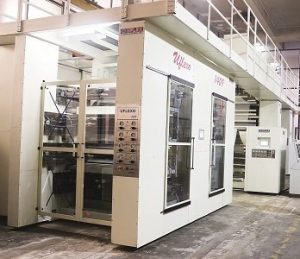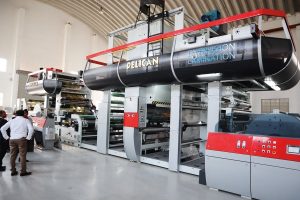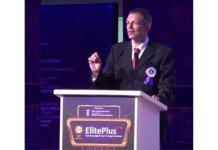
The leading gravure printers in the subcontinent such as Huhtamaki PPL, Uflex, Shrinath Rotopack, Amcor, Constantia India and UMAX have all recently purchased CI flexo presses. They are actively seeking to move gravure reverse printed work with large solid areas and high quality graphics to flexography on not only PE and BOPP substrates but polyester structures also.

The increase of high quality digital flexo platemaking with the leading flexo trade shops means that digital flexo plate resolutions are now approaching 150 and 175 lpi screens. Improved high definition screening means that flexography is being pushed higher and coming closer to the quality produced by gravure cylinder engraved at much higher resolutions that could be described as beginning at 200 lpi. At the same time flat top dots with engineered surfaces are providing better ink transfer in solid areas on flexo presses.
For flexible packaging short runs, there is some saving in flexo plate costs in comparison to the cost of cylinders – perhaps as much as 15%. Another benefit is that flexo plates can be produced and delivered in a matter of hours in comparison to gravure cylinders, which still require time for both engraving and logistics. Of course the skill levels for handling flexo plates and running CI flexo presses is much higher. In India, the wages of a good pressman for a CI flexo press can be double that of a gravure pressman.

Uflex Engineering plant in Noida
With the added perception that CI flexo with its alcohol-based inks is preferable to gravure with its toluene-based inks, it is a technology that the leading flexible packaging converters are increasingly invested in. New press orders are coming to all the CI flexo press manufacturers that are present in the subcontinent – Bobst-F&K, Comexi, KYMC, Uteco and W&H. In addition, there is the new crop of Indian manufacturers with Italian technical collaborations.
There are three Indian manufacturers of CI flexo presses in the fray – Echaar, Manugraph and Uflex Engineering. Amongst these, Uflex Engineering and Manugraph have delivered presses but Uflex seems to be a bit ahead of Manugraph in its time frames. While Manugraph’s first CKD press is installed, Uflex has one press running in its own plant in Haridwar and is in the process of commissioning its second machine in the same location. A further two machines are being manufactured by Uflex Engineering for Indian customers while there are queries from Europe for a press as well.
Ambitiously aimed at markets requiring a high level of automation, the Uflex Engineering CI flexo has aroused interest from a Russian buyer who recently saw the press in day to day production at the Uflex Haridwar plant. Ajay Tandon, president of Uflex Engineering, says he is keen to assure some of the larger flexible packaging converters that the Engineering Division is a committed machinery supplier to its dozens of customers across the country, “They really need to give this high quality CI flexo press a fair look and take advantage of the competitive performance and automation it offers.”

Faster and more automated gravure
While there is a shift in flexible packaging for some of the shorter runs from gravure to CI flexo, it must be borne in mind that for longer runs in Pakistan, Bangladesh and India, converters are looking at faster and more automated gravure presses such as the W&H Heliostar shown at the open house event at the new Balaji packaging plant in Rajkot. Several high-speed Bobst Rotomec gravure presses made in Italy have also been installed in the subcontinent, at leading converters including Huhtamaki and Constantia while several more are on their way.
Converters are keen on faster and more automated gravure presses in order to realize overall production efficiencies and cost savings. Power consumption and energy consumption in the curing process are concerns. In the automated gravure presses designed to run at 450 meters a minute, substrate and ink savings can also be considerable. With the more consistent throughput of the automated presses, converters are looking at savings of 1% to 2% in substrate materials and perhaps another 1% in inks, which can, in a well run operation, be added to the bottom line. It must be kept in mind that while faster gravure presses have been running in the subcontinent for some time, the inks and solvents also need to be geared up to match the faster speeds.
Co-extrusion laminators
Apart from the food and hygiene markets, a key segment that is currently driving the flexible packaging market is the high growth of the snack food segment. In this segment the laminate structure consists of the printed film on the outside and a metallized film on the inside which are held together with a co-extruded polymer layer. In the main, converters use Chinese and Taiwanese co-extrusion laminators while some of the leading converters have co-extrusion laminators from Davis Standard.
Seeing the explosive growth of the snack food segment, several Indian manufacturers (as many as ten by some accounts) are now getting into the manufacture of co-extrusion laminators. Amongst these are Uflex, which showed its co-extrusion laminator at the last PlastIndia exhibition in Gandhinagar, and Pelican, which is building a very robust co-extrusion laminator at its Rajkot factory.











HAPPY NEW YEAR.
KINDLY SEND ME MACHINERY INFORMATION.